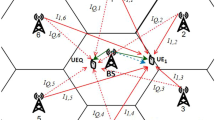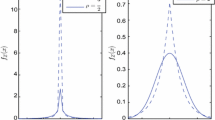Abstract
Considering development of delay-sensitive applications in wireless communications and cellular networks along with lack of system resources and environmental factors including fading and noise all together make it impossible for all users to be active and to achieve quality of service requirements simultaneously. To analyze wireless systems performance, user capacity is defined as the maximum number of users that can be activated at the same time. In order to obtain user capacity scaling laws, channel distribution information is required and channel gains can be estimated by different channel estimators such as minimum mean square error estimators. In this paper, estimated channel gains are substituted for true channel gains and effects of imperfect channel estimation errors on the user capacity scaling laws are analyzed. It is shown that the user capacity scales double logarithmically and there is a gap depending on channel estimators accuracy between the lower and upper bounds. Moreover, assuming estimated channels for different users are independent and identically distributed, it is shown that the user capacity scaling laws are asymptotically tight.





Similar content being viewed by others
References
Jindal, N. (2004). Multi-user communication systems: Capacity, duality, and cooperation. Doctoral dissertation, Stanford University.
Molisch, A. (2011). Wireless communications. New York: Wiley.
Pätzold, M., & Wiley, J. (2002). Mobile fading channels. New York: Wiley.
Viswanath, P., Anantharam, V., & Tse, D. (1999). Optimal sequences, power control, and user capacity of synchronous CDMA systems with linear MMSE multiuser receivers. IEEE Transactions on Information Theory, 45(6), 1968–1983.
Han, C., & Armour, S. (2011). Energy efficient radio resource management strategies for green radio. IET Communications, 5(18), 2629–2639.
Li, D. (2011). Efficient power allocation for multiuser cognitive radio networks. Wireless Personal Communications, 59(4), 589–597.
Naeem, M., Pareek, U., & Lee, D. (2011). Interference-aware joint user selection and quantised power control schemes for uplink cognitive multiple-input multiple-output system. IET Communications, 5(16), 2266–2274.
Dai, J., Chen, M., & Chung, P. J. (2013). The downlink capacity of single-user SA-MIMO system. Wireless Personal Communications, 69(4), 1333–1345.
Oh, C. Y., Chung, M. Y., Choo, H., & Lee, T. J. (2013). Resource allocation with partitioning criterion for macro-femto overlay cellular networks with Fractional frequency reuse. Wireless Personal Communications, 68(2), 417–432.
Ataman, S., & Wautier, A. (2006). Capacity and asymptotic user capacity of a multiservice CDMA uplink with successive interference cancellation. In IEEE international symposium personal, indoor and mobile radio communications, September 2006 (pp. 1–5). Finland: Helsinki.
Boppana, S., & Shea, J. (2006). Downlink user capacity of cellular systems: TDMA vs Dirty Paper Coding. In IEEE international symposium on information theory (pp. 754–758).
Cimini, L, Jr, Foschini, G., & Shepp, L. (1994). Single-channel user-capacity calculations for self-organizing cellular systems. IEEE Transactions on Communications, 42(12), 3137–3143.
Viswanath, P., & Anantharam, V. (1999). User capacity of a power controlled CDMA system with multiple base stations. In Proceedings of the 1999 IEEE, information theory and communications workshop (pp. 21–23).
Kishore, S., Greenstein, L., Poor, H., & Schwartz, S. (2006). Uplink user capacity in a multicell CDMA system with hotspot microcells. IEEE Transactions on Wireless Communications, 5(6), 1333–1342.
Shakya, I., Ali, F., & Stipidis, E. (2011). High user capacity collaborative code-division multiple access. IET Communications, 5(3), 307–319.
Keshavarz, H., Xie, L., & Mazumdar, R. (2008). On the optimal number of active receivers in fading broadcast channels. IEEE Transactions on Information Theory, 54(3), 1323–1327.
Keshavarz, H., Xie, L., & Mazumdar, R. (2009). User capacity scaling laws for fading multiple-access channels. IEEE Transactions on Wireless Communications, 8(9), 4498–4507.
Keshavarz, H., Xie, L., & Mazumdar, R. (2008). User capacity of Rician and Nakagami fading broadcast channels. In IEEE GLOBECOM Global telecommunications conference (pp. 1–5).
Keshavarz, H., Xie, L., & Mazumdar, R. (2008). User capacity of fading multi-user channels with a minimum rate constraint. In IEEE international conference on communications, ICC’08 (pp. 4649–4653).
Ha, T. (2011). Theory and design of digital communication systems. Cambridge, MA: Cambridge University Press.
Punchihewa, A., Bhargava, V., & Despins, C. (2011). Capacity and power allocation for cognitive MAC with imperfect channel estimation. IEEE Transactions on Wireless Communications, 10(12), 4001–4007.
Yoo, T., & Goldsmith, A. (2006). Capacity and power allocation for fading MIMO channels with channel estimation error. IEEE Transactions on Information Theory, 52(5), 2203–2214.
Yoo, T., & Goldsmith, A. (2004). Capacity of fading MIMO channels with channel estimation error. In IEEE international conference on communications, 2, 808–813.
Cover, T., & Thomas, J. (2006). Elements of information theory. New York: Wiley.
Motwani, R., & Raghavan, P. (1995). Randomized algorithms. Cambridge, MA: Cambridge University Press.
Author information
Authors and Affiliations
Corresponding author
Appendices
Appendix 1: Rayleigh Fading
Consider the multi-user channel, with the independent gains \(\hat{h}_i\sim {\mathcal {C}}{\mathcal {N}}\left( 0,\hat{\sigma }^2_{h,i}\right) \) for \(i=1,\ldots ,n\). Then, \(|\hat{h}_i|\sim { Rayleigh}\left( \sqrt{\hat{\sigma }^2_{h,i}/2}\right) \) and \(|\hat{h}_i|^2\sim {\Gamma }\left( 1,\hat{\sigma }^2_{h,i}\right) \) for \(i=1,\ldots ,n\). Hence, the cumulative distribution function of \( |\hat{h}_i|^2 \) according to the Gamma distribution is given by
where \( \Gamma (\cdot ) , \Gamma (\cdot ,\cdot )\) and \(\gamma (\cdot ,\cdot ) \) are the gamma, the upper incomplete gamma and the lower incomplete gamma functions respectively (see [18, Eqs. (13)–(15) and (23)]).
Appendix 2: Rician Fading
Consider the multi-user channel with independent gains \(\hat{h}_i\sim {\mathcal {C}}{\mathcal {N}}\left( \hat{\mu }_i,\hat{\sigma }^2_{h,i}\right) \), for \(i=1,\ldots ,n\); if \( \tilde{h}_i\sim {\mathcal {C}}{\mathcal {N}}\left( \hat{\mu }_i,2\right) \), according to Lemma 9.1, \(|\hat{h}_i|=|\sqrt{\hat{\sigma }^2_h/2}\tilde{h}_i|\sim Rice\left( \sqrt{\hat{\sigma }^2_{h,i}/2},\sqrt{\hat{\sigma }^2_{h,i}/2}\hat{\mu }_i\right) \) and \(|\tilde{h}_i|^2\sim {\mathcal {N}}{\mathcal {C}} \chi _2^2\left( \hat{\mu }_i^2\right) \) (i.e. non-central Chi-square distribution with two degrees of freedom) with the cumulative distribution function
As \(\hat{h}=\sqrt{\hat{\sigma }^2_h/2}\cdot \tilde{h}\), the distribution function of \(|\hat{h}|^2\) equals to
Lemma 9.1
Consider a Rician random variable \(X\sim Rice(\xi ,\kappa )\). For any positive \(r\) , if \(Y=rX,\,Y\) is distributed as \(Rice(r\xi ,r\kappa )\).
Proof
\(\square \)
Appendix 3: Nakagami Fading
Consider the multi-user channel with independent absolute gains \(|\hat{h}_i| \sim Nakagami({\hat{\Omega }}_i,\hat{m}_i)\) for \(i=1,\ldots ,n\). Then, \( |\hat{h}_i|^2 \sim \Gamma (\hat{m}_i, {\hat{\Omega }}_i/\hat{m}_i) \) with the cumulative distribution function
Rights and permissions
About this article
Cite this article
Eslami, A., Keshavarz, H. User Capacity Scaling Laws of Multi-user Fading Channels in the Presence of MMSE Channel Estimators. Wireless Pers Commun 77, 2465–2482 (2014). https://doi.org/10.1007/s11277-014-1647-9
Published:
Issue Date:
DOI: https://doi.org/10.1007/s11277-014-1647-9




